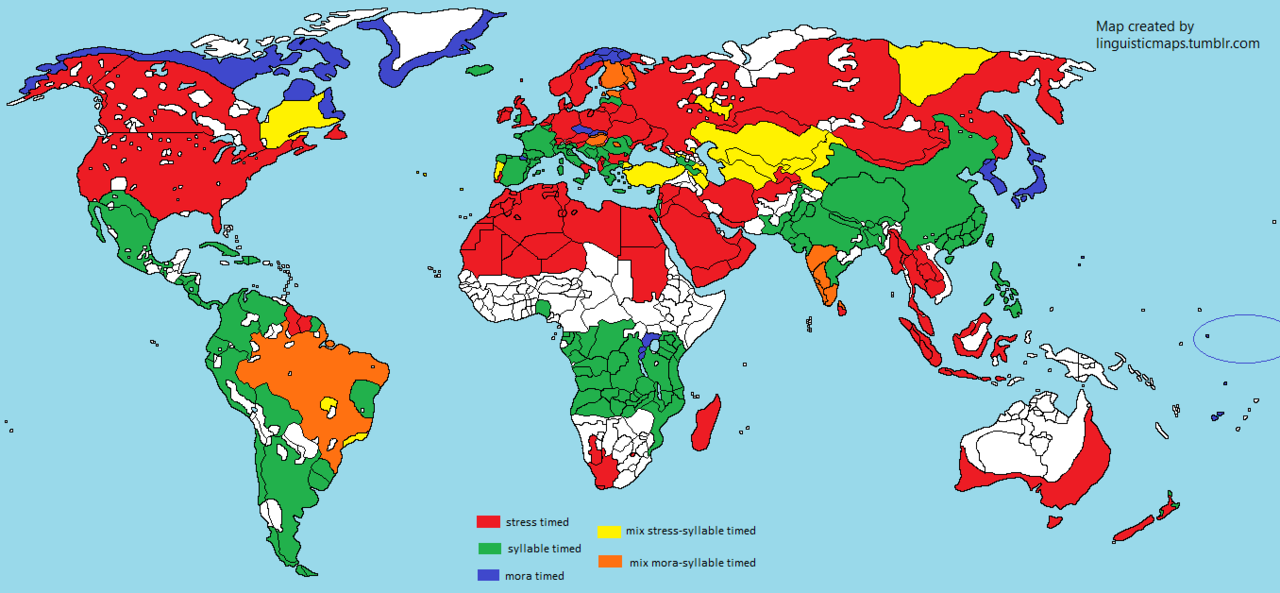1. Did the piece hold your attention? How?
2. Does the composition stand on its own without the visuals? Why? Why not?
3. Did the music sound mechanical? Is that a bad thing?
4. Can this kind of music express emotion?

Rhythmic patterns in languages

Where is your native language located?
Red. Stress timed - languages usually with strong vowel reduction, lexical stress, complex syllable structure, a bigger ration of consonants in relation to vowels. The intervals between stressed syllables are about even.
Green. Syllable timed - languages usually lacking vowel reduction, fixed stress or not, simpler syllable structure, more percentage of vowel time. The time between syllables is about the same.
Blue. Mora timed - languages usually with long vowels and geminate* consonants, simple syllable structure. The time between two moras (a sub-syllable constituent) is about the same.
Yellow and orange. Mixed types - have mixed characteristics between two of the three types above.
In English we don't speak in a strict metre, but we do in fact speak in a kind of metre that we stretch and contract to emphasise the aspects of our speech we want to draw attention to. We speak with a 'rubber band'....
Say these word collocations, notice the percussive effect of this repetitive but rhythmically and texturally varying text. Think of yourself as a drummer doing little drum rolls with your tongue:
economic forces, economic goal, economic growth, economic inequality, economic integration, economic interests, economic policy, economic power, economic prosperity, economic reform, economic relations, economic relationships, economic resources, economic sector, economic stability, economic status, economic structure, economic success, economic system, economic theory, economic value, economic welfare
educational institution, educational opportunity, educational policy, educational programme, educational provision, educational qualification, educational research, educational setting, educational system
effective communication, effective implementation, effective intervention, effective management, effective method, effective participation, effective policy, effective treatment
Notice how you package each collocation into the same space, regardless of how many syllables there are or where the stress comes in the words. That's what stress-timed language is about - "economic growth" (5 syllables) and "economic prosperity" (8 syllables) are articulated over the same metrical portion. We may vary our tempo or even pause for effect, but we are still obeying a metre. A phrase like "educational participation" is quite a tricky 'drum roll' due to where the stressed syllables come. If we notated how people articulate this phrase we'd find they need to 'get in' before the beginning of the main beat of their sentence so that the stressed syllables will fall 'on the pulse' where we expect to hear stress. In this sense, English is quite a rhythmically elaborate language, which if it were musical would be rather like free jazz.
*Gemination is the doubling or deliberate lengthening of a consonant sound. It is not common in English, but is found when the last consonant in a given word and the first consonant in the following word are the same fricative, nasal, or stop. For instance:
calm man [ˌkɑːmˈmæn]
this saddle [ðɪsˈsædəl]
midday [ˈmɪd.deɪ]
lamppost [ˈlæmp.poʊst] (cf. lamb post, compost)
cattail [ˈkæt.teɪl] (compare consonant length in "catfish")
roommate [ˈrum.meɪt]
subbasement [ˌsʌbˈbeɪsmənt]
evenness [ˈiːvənnəs]
misspell [ˌmɪsˈspɛl]
prime minister [ˌpraɪmˈmɪnɪstər]
In Japanese, gemination is represented with the sokuon, a small tsu: っ for hiragana in native words and ッ for katakana in foreign words. For example, 来た (きた, kita) means "came; arrived", while 切った (きった, kitta) means "cut; sliced". With the influx of foreign words into Modern Japanese, voiced consonants have become able to geminate as well: バグ (bagu) means "(computer) bug", and バッグ (baggu) means "bag". In some variants of colloquial Modern Japanese, gemination may be applied to some adjectives and adverbs in order to add emphasis: すごい (sugoi, "amazing") contrasts with すっごい (suggoi, "really amazing").
In English we don't speak in a strict metre, but we do in fact speak in a kind of metre that we stretch and contract to emphasise the aspects of our speech we want to draw attention to. We speak with a 'rubber band'....
Say these word collocations, notice the percussive effect of this repetitive but rhythmically and texturally varying text. Think of yourself as a drummer doing little drum rolls with your tongue:
economic forces, economic goal, economic growth, economic inequality, economic integration, economic interests, economic policy, economic power, economic prosperity, economic reform, economic relations, economic relationships, economic resources, economic sector, economic stability, economic status, economic structure, economic success, economic system, economic theory, economic value, economic welfare
educational institution, educational opportunity, educational policy, educational programme, educational provision, educational qualification, educational research, educational setting, educational system
effective communication, effective implementation, effective intervention, effective management, effective method, effective participation, effective policy, effective treatment
Notice how you package each collocation into the same space, regardless of how many syllables there are or where the stress comes in the words. That's what stress-timed language is about - "economic growth" (5 syllables) and "economic prosperity" (8 syllables) are articulated over the same metrical portion. We may vary our tempo or even pause for effect, but we are still obeying a metre. A phrase like "educational participation" is quite a tricky 'drum roll' due to where the stressed syllables come. If we notated how people articulate this phrase we'd find they need to 'get in' before the beginning of the main beat of their sentence so that the stressed syllables will fall 'on the pulse' where we expect to hear stress. In this sense, English is quite a rhythmically elaborate language, which if it were musical would be rather like free jazz.
One thing you might have noticed and might struggle with is the way English speakers often drop whole syllables when saying certain longer words.
average
novelist
happening
what do these three examples have to do with r, l and n?
Before /r/
considerable
favourable
battery
dictionary
conference
history
imaginary
difference
interest
miserable
preferable
mystery
secondary
restuarant
Before /l/
accidetally
carefully
family
especially
partially
dreadfully
thankfully
Before /n/
educational
national
personal
deafening
definite
frightening
prisoner
traditional
First listen for a minute without the the visuals. Then listen with them. How did the visuals change your experience?
Comments from You Tube viewers
Starchy the Potato 1 year ago
Color is timbre, length is time, and height is pitch, but
what are those peach areas around some groups of notes?
Cypeq 11 months ago
also size of objects represents their volume. Top circles
are channels, and peach is reverb.
Dušan Dakić3 years ago
Has anybody looked at the circles? The black part represents
where is sound coming from: left or right.
tp11051965 3 months ago
Actually the original recording is quadrophonic. So the
circles on top of the score represent front, back, left, right speakers. And
the colors of the circle segments refer to corresponding sound symbols in the
score.
Discuss
Vocab:
You may 'know' many of these words, but what do they mean when we are talking about music?
beat
accent
high / low
note
notate
bar
line
score
feel
time
arrangement
Go to Ted Lesson:
A different way to visualize rhythm
Discuss
Why is the Rubin's vase useful in understanding how we perceive rhythm?
Now circle the correct option:
1. For musical rhythm, a steady string of repeating single beats is enough / not enough.
2. Which ends up being heard as the main be is / is not a precise rule.
3. The flow of rhythm can / cannot be traced in a circle.
4. A wheel can be a more / less intuitive way to visualise rhythm than a linear score.
5. Rock music often uses a 4-beat / 3-beat rhythm.
6. In an 8-beat system an extra layer can increase accuracy / reinforce the secondary beat
7. The wheel method helps us to hear / visualise rhythm.
Now watch again and check your answers.
Final task:
Vocab focus: adjectives in colocations. Try unscrambling the adjectives in bold and then listen to check.
to make diinctst
curalltu perception
nealir passage of time
a searcondy beat
iplmulte patterns
centoncric wheels
cmpleox rhythms
rognbliecsae backbone
genres paropul around the world
undegrlyin feel
a robad range of
yithmrhc configuration
ulturcal context
a ntyif way of visualising
a usmical journey
NB: Notice how adjectives usually compliment a following noun.
Can you find the case where the adjective is the object of a verb?
Can you find the case where the adjective follows the noun?
Pithoprakta (w/ graphical score)
Reading - 4 minutes
staggeringly relatively
Design and music intersect in many areas; fashion, art, filmmaking and set design, yet one relatively obscure but __________ creative area, is in the design of graphic notation used by composers. Graphic notation is one side that is ___________ unknown outside the sometimes rarefied world of orchestral and experimental music.
Composers have always grappled with ways to express themselves, and in the twentieth-century, several began using this radical graphical approach to writing scores. It was a two-fingered salute to the prevailing musical establishment.
Q: What do the phrases in bold mean?
And the Sistine Chapel of graphic scores:
TREATISE Cornelius Cardew. KYMATIC ensemble



No comments:
Post a Comment